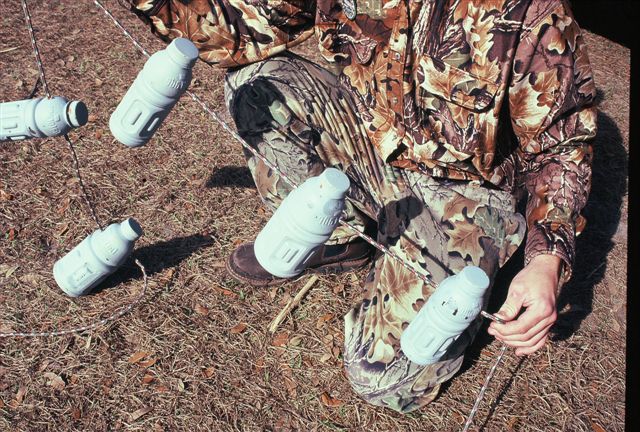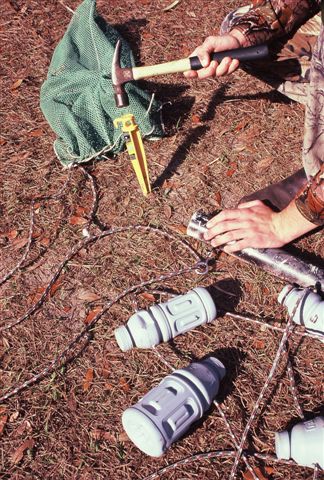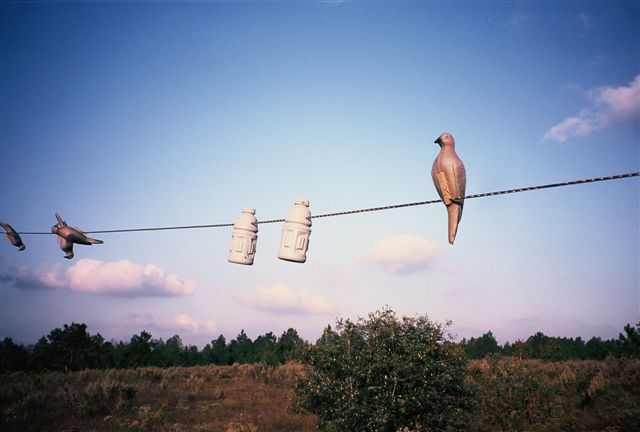Doves, On A Wire
Bob McNally 09.10.13

If you hunt mourning doves, or simply observe them, you undoubtedly know doves have an uncanny affinity for power lines. Telephone and electric lines are choice resting sites for doves. Birds typically land on such wires before descending to the ground to feed, get grit, or water. This is such a widely known dove habit that in most hunting areas where there are power lines, hunting sites around wires are coveted.
Power lines are so attractive to doves that many fields owned by hunters have specially-built “utility wires” that serve no other purpose but as an attractant for doves. A wire, complete with tall poles, looks exactly like a telephone line, often extending for hundreds of yards across an otherwise flat field. Except it has no power or telephone hook-ups. It’s put there solely to draw birds when dove season opens.
But not everyone can afford to build his own “power line to nowhere” in a dove field. Yet with a bit of effort and for not much money, you can build your own “dove wire” that attracts birds from long range, and it’s easily portable.
The components of a portable “dove wire” (all available at most hardware stores) include: a 20-foot long 2-inch diameter PVC pipe; 2 four-inch long, 1/4-inch diameter “eye-bolts” with four suitable lock nuts; 2 five-foot lengths of concrete reinforcement rod (rebar); a 100-foot length of dark-color (black best) 1/4-inch rope (nylon good); two tent stakes; one to two dozen plastic drink containers (20-ounce or slightly larger); and a large spray can of flat-gray primer paint, plus a large can of flat-black paint.
For tools, you need a saw, a drill with 1/4-inch bit, and a hammer.
First step cut the PVC pipe in half, producing two 10-foot sections. This makes the pipe more portable, able to fit inside most SUVs and pickups, and many hardware stores will cut the pipe for easy transport. Next completely spray the outside of the PVC pipes with flat-black paint, and let dry.
Remove labels from plastic drink containers, and drill one hole sideways completely through them with a 1/4-inch bit. Just an inch or so down from the cap is a good spot to drill through. Thread drink containers onto the rope. They should slide on snug. You don’t want them to move too easily along the rope. Space them irregularly at various spots along the rope, leaving about 15 feet of bare rope at each end without drink containers. You can spray the drink containers with flat-gray primer paint now, but it’s easier when they’re suspended above the ground on the “dove wire.”
When the PVC pipes dry from painting, drill one 1/4-inch hole through each pipe, about 4-inches from an end. Thread one lock-nut onto the eye-bolt, and spin it far back on the threads. Now put the eye-bolt through the PVC hole, and secure it in place with another lock-nut. The eye-bolt should be sturdy and secure, capable of holding the rope with plastic “decoys.” Do this to both PVC pipes.
Practice setting up the dove wire at home in your back yard, a nearby field, park or other open space. It’s much faster with another person’s help.
Take one of the 5-foot lengths of steel rod and drive it well into the ground with a hammer. A foot or two deep is good. Thread one end of the rope through a PVC eye-bolt, pull it through six or eight feet, then slide the opposite end of the PVC pole over the rebar rod, so the pole is standing upright. Several feet from the vertical PVC pole drive one tent stake into the ground, and secure the end of the rope to the tent stake.
Lay the rope with plastic decoys on the ground in a line leading away from the vertical PVC pipe. This should extend about 70 feet or so. At that spot drive the second steel rod into the ground. Thread the remaining end of the rope through the second PVC pipe eye-bolt, and while holding the rope end, slide the opposite end of the PVC pipe over the rod so it’s standing upright on the rebar, eyebolt at the top.
Pull slowly and firmly on the rope end so the decoys rise and are suspended between the poles. Step several feet away from the second PVC pipe, drive the second tent stake into the ground, and secure the “dove wire” to it.
Adjust decoys by sliding them along the rope, so they look like real doves on a wire. You can add a few oversize plastic bottle decoys on the ground under the wire for more realism. Attaching a few commercially-made plastic dove decoys is okay, too. The whole thing goes up in a few minutes, and comes down even faster.
In fields you regularly hunt, a “dove wire” can be left disassembled along a woods line or ditch, then set-up when needed. This eliminates the need for transporting the components every time to a hunting site.
Taller and longer “dove wires” are easy to make, too. You can use two, 100-foot lengths of rope tied together, utilizing three poles. For a taller “wire” set-up, use two 20-foot lengths of PVC, and 3-inch diameter pipes to make it more sturdy. Transporting such long pipe can be difficult in hunting vehicles, however. But pipe can be cut into 10-foot sections, then glue threaded PVC connectors to the ends. This makes it easy to transport pipe, then at the hunting site pipe can be threaded together forming 20-foot tall “poles,” which gets decoys high where they’re easily seen by incoming birds from long range.


